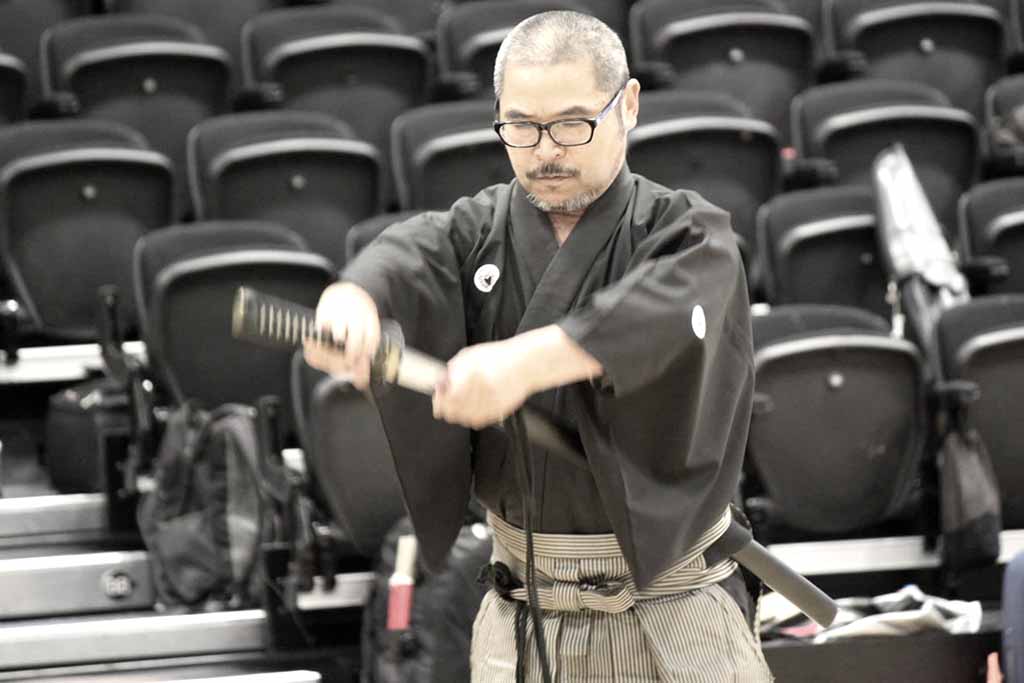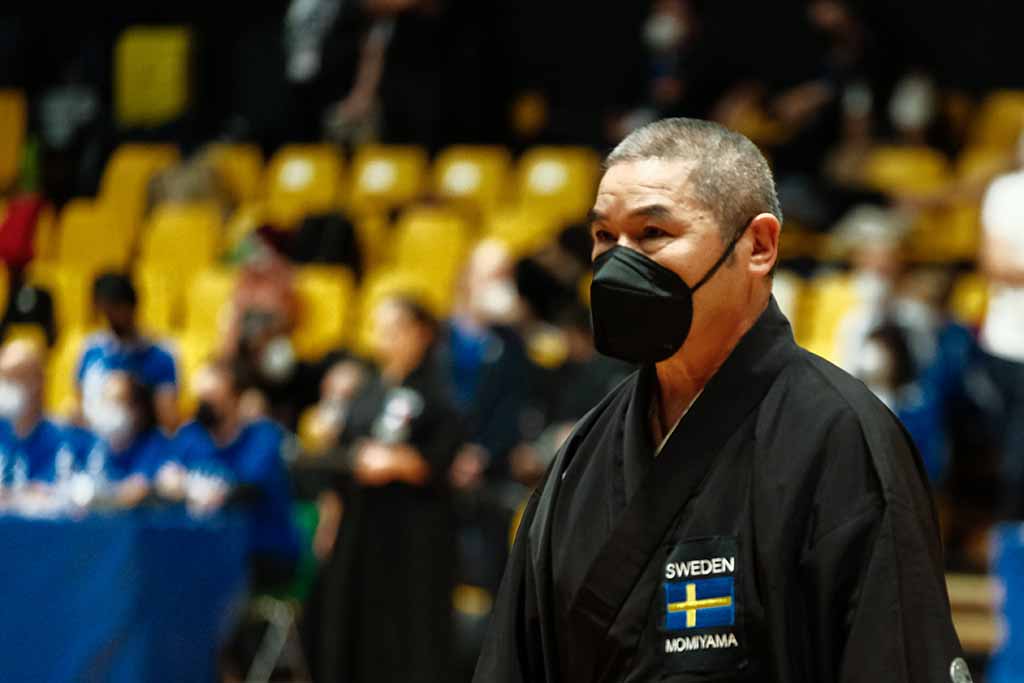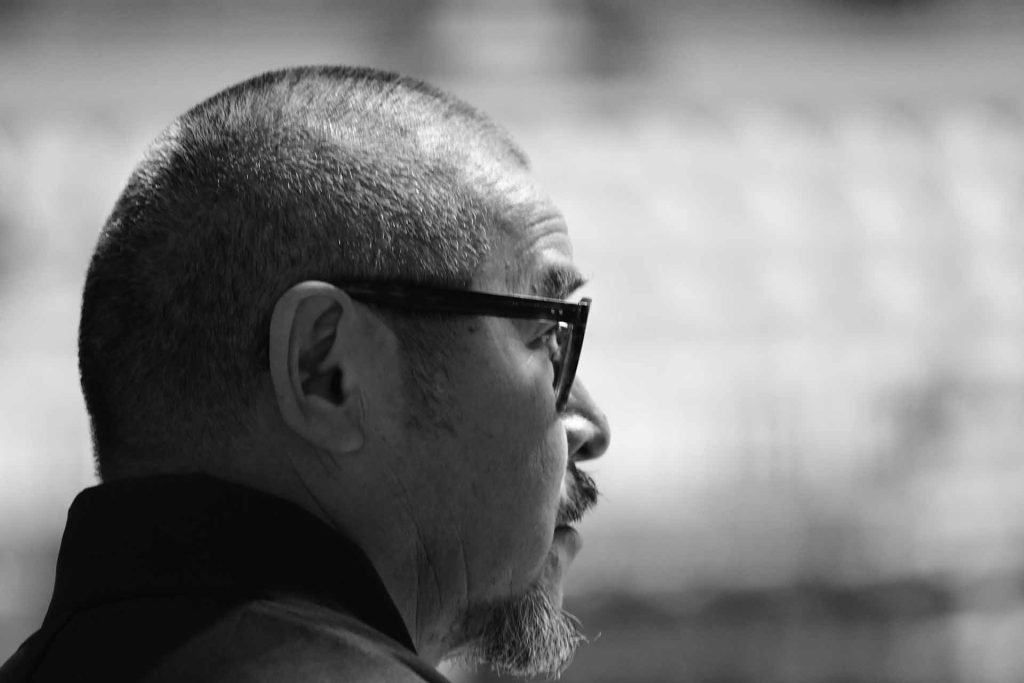Versione Italiana qui
It was 2021 when Gabriele Gerbino interviewed Momiyama Takao sensei in the role of referee at the European Iaido Championship (see https://kiryoku.it/eic-interviews/), when he firstly had the chance to ask him about his feelings, his referee experiences and about the difficulties and the relevance of such championship for European Iaido.
After a few years, Kiryoku project to retrace the history of European iaido through the life of those who contributed to its development, brought us knocking again at Momiyama sensei’s door to spend a pleasant time with him to know something more about a whole life spent in Budo.
Momyiama sensei, thank you so much for your availability in participating in our project, it’s a pleasure meeting you again to offer iadoka from all over the world the chance to know more about your life and history, as you practiced in different disciplines, covered different roles and have so much to teach us, and I’m not talking about the technique alone.
You were born in Japan but then moved to Sweden: to better position you in the proper time of European iaido development, when were you born and when did you start practicing the arts of the sword?
I’m 72 years old, born May 05th, 1951, and my first encounter with a sword was in 1967, when I started practicing Kendo at the high school kendo club when I was 16 years old but I started practicing judo when I was 12 years old, for three years.
I later started practicing iaido, it was 1983, and jodo in 1984 at Komaki dojo in Stockholm, Sweden, practicing under Komaki Kazuhiro sensei guidance, 7 dan kyoshi Zen Ken Ren and member of the Swedish kendo federation.

With more than fifty years of experience in these disciplines I can imagine you had the chance to be an active part of several dojo contributing to others as well as your growth in budo: what is your current dan grade in all of them?
Indeed, since I moved to Sweden I firstly joined Komaki dojo from 1983 to 1987, then Zen Kobudo Centrum, from 1987 to 2005, and Glimminge Budokan from 2005 to these days.
I’m currently kendo 5 dan, iaido 7 dan kyoshi and Jodo 7 dan kyoshi.
This is really a great acknowledgment for a passionate budoka. Would you tell us more about your growth in budo? Starting from your first steps how it then developed into a full commitment to you?
In Komaki dojo, Komaki sensei was teaching kendo and iaido and I became kendo teacher assistant, while sensei was inviting all his kendo students to apply to iaido practice too. Since the beginning I really liked Kendo Kata-keiko, and then, as I kept practicing, I realised budo or bujutsu practice was suiting me.
Komaki sensei visited Ishido sensei’s dojo in Kawasaki already 1979 or 1980 and invited Ishido sensei to Stockholm 1981 after his teaching trip to England or Holland. It was around that period of time that my lifework of Iaido and Jodo started, in 1983 and 1984 respectively.
But is was 1981 the special year for Swedish budo federation, when the japanese budo delegation, including Kaminoda Tsunemori 8 dan Jodo and Iaido hanshi, who passed away in 2015 at the age of 88, visited Stockholm together with Otake shihan, Katori Shinto Ryu, with his son and the internationally known Donald Frederick “Donn” Draeger (April 15, 1922 – October 20, 1982), a worldwide appreciated teacher and practitioner of Japanese martial arts.
My studies started with kendo, and only some years later I also approached iaido and jodo, nearly at same time: my experience in budo grew as long as I was progressing on some basics as footwork, bodywork, eye contact, balance, finding good timing and appropriate distance, then developing a fighting spirit. Everybody should effectively study these important elements from each art, by practicing them all as often as possible and for many years.

These are indeed those interesting historical details of our martial arts we like to share through these interviews, along with all those connections with teachers whose life and stories we use to read about. Everything had to be built from scratch in Europe, what was the Iaido dojo scenario when you started?
A lot of time passed since that time and I pleasantly remember we used to do a lot of basic practice and a lot of keiko only performing Zen Ken Ren Iaido first kata, Mae.
At that time Zen Ken Ren Iaido kata were simply called Seitei kata or Seitei gata.
May I ask you to tell us more about the relationship with your sensei?
My sensei is Ishido Shizufumi, Iaido 8 dan hanshi, Jodo 8 dan kyoshi, kendo 7 dan kyoshi, ranked by AJKF, All Japan Kendo Federation also known as ZNKR, Zen Nihon Kendo Renmei.
It was 1985 when I first met Ishido senesi, during a summer seminar in Birmingham: Komaki sensei introduced me to Ishido sensei and starting from the following year, 1986, I spent two months, June to August, practicing at Ishido’s dojo in Kawasaki. Since then, I use to practice at Shinbukan, in Kawasaki, once or twice every year.
I am now one of his Monjin and also the contact person for Swedish and Finnish students.

You undoubtedly took advantage of following guidance from sensei in Europe as well as in Japan: did you experience any difference between their teaching models? Is there anything that might apply considering the relation you have with your sensei compared to yours with your students?
Generally, the Japanese teaching method is oriented in spending more time looking at what your sensei is showing when performing a kata, then students try to repeat what sensei just did. This is mitori keiko.
An advantage of this Japanese teaching model is that students spend more time on self-study and individual lessons.
On the other hand, my understanding of the Western approach revolves around group training, so students are doing kata together. My personal experience with western teaching model is inviting students into group training rather than indulging in self-study.

So practice and teaching is deeply interconnected with the eastern approach: when did you start thinking about teaching and did you develop a personal taste of what the preferred class can be?
I started teaching iaido in 1987: at that time our budo club had three children who wanted to practice iaido and jodo, and this was the reason why I started teaching. Everything I taught them in my class was what I learnt from each summer seminar I attended in England and Holland, and then later in Germany also, practicing with Ishido sensei.
I then stopped teaching iaido or jodo to kids under the age of 15 years. I prefer inviting them to attend different martial arts classes such as Judo, Jujutsu, Aikido or Kendo in other budo clubs.
Aside from the age preference, I have always taught for small groups in my class, so as to allow them to develop slowly while trying to study budo together, under Ishido sensei’s guidance.

So it is only about age and group dimension, and now you definitely shaped your class, how is your typical iaido lesson?
My typical approach to iaido lessons is based on a progression through fundamentals. Early students approaching iaido have to practice nuki tsuke and noto for three months before I start teaching the first kata. I use to give my students every information I get from Ishido sensei, and all new things to come that might be of any interest and relevance. I like to think of my dojo as a Iaido-lab for those who want to study iaido with their own tempo and everybody practicing in my dojo has to be considered a student, including myself.

Back again to your fifty year long career in budo, you surely passed through different ages and maturity levels of iaido: is there a way to define its changes through the years?
During my whole life in iaido I understood iaido itself never changed, but how to study iaido has been changing through all the time, especially for those who are EKF and IKF members: as an example, today we have now twelve ZNKR iaido forms, there were not so many at the beginning.
Then we have several koryu to study, according to your own school: the birth of ZNKR led more people within the IKF to practice less koryu, and this is possibly the biggest change we are witnessing today.
On the other hand, ZNKR iaido greatly contributed to the interest growth about iaido also outside of Japan, and this is something very positive we have not to forget about.

It’s always so intriguing discussing how different cultures affect practicing something, what values might be differently considered and so often disciplines such as iaido are gold mines to be entertained in talking about. As for every discipline there is so much behind the pure “sport” action, but do you think non-Japanese iaidoka can truly understand the culture and “philosophy” behind Iaido?
Honestly, this is a very difficult question to me. I believe we have role models for this question, such as Jock sensei and Louis sensei.
I can say the reason why I decided to go to Kawasaki city in Japan where Ishido sensei has his Shinbukan dojo was because I saw his performance in Birmingham, in 1985. I wanted to understand Japanese culture and philosophy much more deeply. I believe the best way for non-Japanese iaidoka to get better accustomed to iaido is experiencing life in Japan and learning to speak Japanese, as a starting point.
My personal way of trying to understand iaido better is how much we understand what we do in our everyday life. I try to do keiko as much as possible and to study iaido as deeply as possible just to understand something.

Continuing on the same topic as for better understanding of iaido and its development, what do you think about the future of European Iaido?
It is fundamental that the iaido is practiced and studied with the most depth as possible. It is also important to deliver what we learn from our sensei, so if we keep studying proficiently and keep hosting seminars as we do now, we’ll then be successful in delivering a good iaido to the next generations.

Once again we reached the end of this pleasant new discussion without realising how time flies when we engage in topics we love with so available people. There are so many other questions I would like to ask you that might require quite a long time, so not to abuse your kind availability I would propose you a short game, let’s call it 3x3x3: three questions to be answered in three seconds with three words. Ok, just kidding, you can use some extra words.
Thank you so much Momiyama sensei for so many precious details on your life and experience, and see you during the next European Seminars or Championship.
Ready for the 3x3x3? Let’s go!
What would you suggest to young and beginner Iaidoka?
Just get practice.
(as tomorrow is the first day of your rest of life)
What is a budo teaching you particularly like transmitting?
To study “respect”.
What is Iaido to you, its meaning, what does it offer you?
A part of my daily life.












